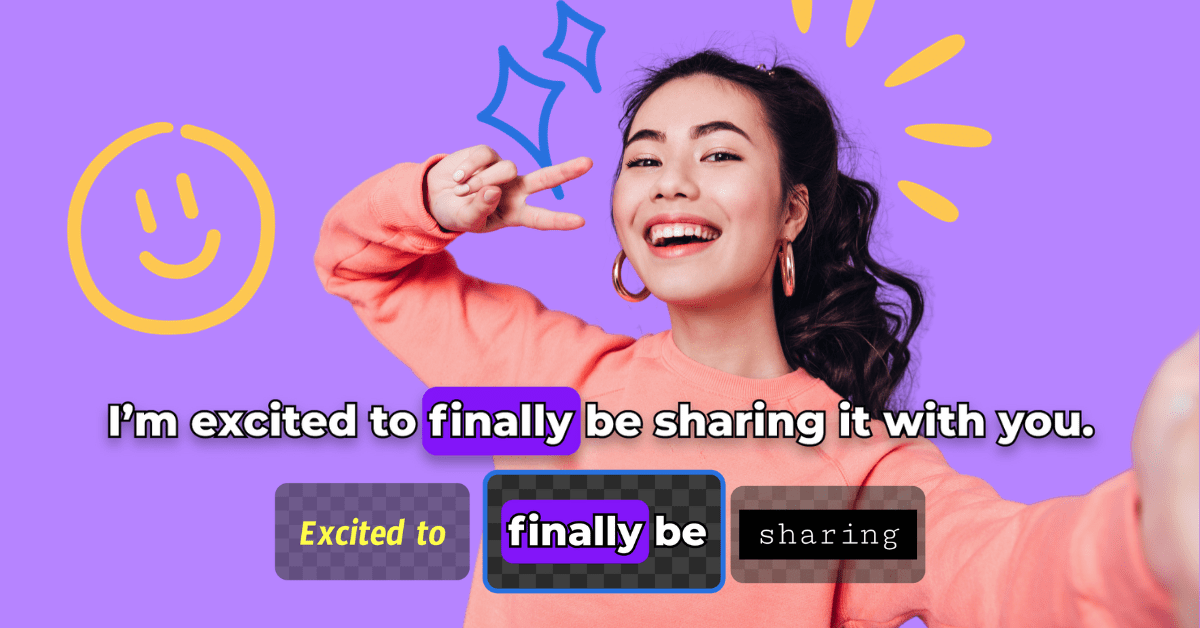
6 min read
How To Choose the Best Subtitle Font and Style for Your Business
Create fun and engaging content with LOVO’s auto caption generator! 1000s of creators are using Video Caption Generator to set their content apart.
Increase your reach with fun and engaging captions that take only minutes to create, thanks to LOVO's video caption generator. Say goodbye to the tedious task of adding captions to your video and audio files with Genny's fast and accurate auto caption generator. You can personalize and animate your captions to create captivating content for your audience in over 20 languages. Now, with Genny's advanced speech recognition software, you'll never have to type out all your captions again. Simply let Genny transcribe and generate captions for you with lightning speed and precision. Then download your SRT file or hardcode the captions into your video - it's that easy!
Try auto captions for freeGenny will automatically generate captions for you in seconds. You can also manually type your own if you prefer full control.
Select the look and feel that best fits your brand and video - change the color, font, and background of your captions. Animate captions for maximum engagement.
Choose between downloading your captions as separate a SRT file or hardcoded into your video.
Try automatic subtitle generator
14-day free trial of Pro plan.
Animate your auto generated captions and highlight keywords to ensure your message stands out and captivates your audience. Use dynamic captions to showcase your creativity and keep your audience engaged from beginning to end.
Auto generate captions for freeUse auto generated captions to increase your reach and expand your audience. Available in over 20 languages, transform your content into multiple languages through the power of a video caption generator.
Add multilingual captionsMake your captions your own and on brand and by selecting the font, color, and background color that best suits your video. In just a couple of clicks, Genny’s video caption generator will create exciting and dynamic captions that are the perfect fit!
Generate dynamic captionsFast, accurate, and reliable. With our advanced video caption generator, captions are created 3 times faster with 30% higher accuracy than other services. Reduce the time you spend editing and say goodbye to typing out captions.
Add video captions nowCaptions hold an audience’s attention for longer and increases engagement. In a study by Plymedia, researchers found that videos with subtitles increase engagement up to 40% and the likelihood of viewers watching the enitre video by 80%!
A video available in multiple languages instantly boosts its reach and helps to grow a global audience. Using AI captioning turns videos into a searchable script increasing SEO and improving a video’s keyword density and diversity.
Creating content with captions raises inclusivity and accessibility. Including auto generated captions ensures your content reaches everyone regardless of language or if they are hard of hearing or deaf. Captions breaks down many barriers to allow anyone to enjoy your content.
Try automatic subtitle generator
14-day free trial of Pro plan.

6 min read
How To Choose the Best Subtitle Font and Style for Your Business

5 min read
3 Reasons Why You Should Generate Subtitles in Your Videos in 2024

6 min read
How to add subtitles to your video in minutes with LOVO’s Auto Subtitle Generator

6 min read
Closed Captioning vs Subtitles: Understanding the Differences
Subtitles are written representations of spoken dialogue, narration, or other audio elements in a video, film, or multimedia content. They usually appear at the bottom of the screen and provide a written transcription of the audio in the same language or a translated form.
Video Captions have multiple benefits:
1. Accessibility:they make the content accessible to individuals who are deaf or hard of hearing, which is crucial to ensure that they can comprehend and follow the content without any hindrance.
2. Multilingual Support: By providing captions in various languages, a video caption generator allows a wider global audience to comprehend the content.
3. Improved Comprehension: The presence of video captions can help improve content comprehension, especially when dealing with accents, dialects, or complex dialogue. Additionally, captions can be helpful in noisy or distracting environments, like crowded public spaces, allowing viewers to follow the conversation more easily.
4. Environmental Considerations: Subtitles allow viewers to follow the dialogue in noisy or distracting environments, such as crowded public spaces.
5. SEO: AI captioning can be a powerful tool to enhance the discoverability of video content by assisting search engines to index and rank it effectively.
To put it briefly, using a video caption generator and automatically generating captions will improve the approachability and functionality of multimedia content, thereby making it more comprehensive, user-friendly, and appealing to a wide range of viewers.
Including subtitles in video content is crucial as it enables the audience to receive information through text. Two types of captions that are commonly used are static and animated video captions.
Captions classified as static remain fixed at the bottom of the screen throughout the entire duration of the video playback. These captions are commonly used in traditional media forms like movies and documentaries. The static nature of these provides consistency and simplicity to the viewer, providing a stable reference point for the text.
In contrast to static captions, animated captions incorporate dynamic effects to the text that change or move during video playback. These captions are commonly seen in creative, artistic, or youth-oriented videos as they add an engaging visual element to the text.
Automatic subtitles, commonly referred to as closed captioning, are generated through the use of speech recognition technology and natural language processing.
The process begins with an audio or video file containing spoken content, which is uploaded to a video caption generator and then converted into written text using an automatic speech recognition (ASR) system.
Automatic Speech Recognition (ASR) technology is capable of recognizing individual words and generating a written transcript of the spoken content. To enhance the accuracy of the generated text, it may undergo Natural Language Processing (NLP), which can correct errors, identify the context, format the text to make it more readable, and add the necessary punctuation.
To synchronize text with the audio, timestamps are added to each line of text. Once the text is finalized and timestamped, it can be formatted and added to the video file or provided as a separate subtitle file. The most commonly used subtitle file format is SRT.
These subtitles generated by an auto caption generator are typically presented at the lower part of the screen and can be personalized in terms of font, size, and design.
The SubRip Subtitle file, commonly known as an SRT file, is a popular file format used for saving subtitles or closed captions in video content. These files are in a simple text format that can be easily read by humans and consist of timed lines of text. They provide information about when particular content should be displayed on the screen while watching a video.
SRT files have become a popular choice for adding subtitles or closed captions to videos, as they are compatible with various video players and editing software. Moreover, they are widely used for translating subtitles into different languages and ensuring proper timing for accessibility. If you use Genny as a video caption generator, you have the option to download them as an SRT file or hardcode them into your video.
Burned-in subtitles, also called hardcoded subtitles or open captions, are a kind of subtitle that is added to the video image during the encoding process and cannot be removed or personalized by the viewer. These video captions are always visible at the bottom of the video frame.
Captions play a vital role in videos, especially in cases where understanding the content is crucial, such as foreign language films or videos with critical dialogue. They are a permanent and indispensable component of the video.
Adding captions to content by using an auto caption generator can improve its accessibility, engagement, and comprehension. There are various reasons why people choose to do so, but the most prevalent ones include:
| ✅ Accessibility | Captions are crucial for individuals who experience hearing difficulties or are completely deaf. |
| ✅ Global Audiences | Making use of subtitles generated by a video caption generator can help to make content available to people from around the world and those who come from diverse linguistic backgrounds. |
| ✅ Clarity | Enhancing the transparency of verbal communication and assisting the audience to comprehend the content in noisy surroundings are some of the benefits provided by them. |
| ✅ SEO | Subtitles can boost video content's search engine optimization (SEO) and help ensure compliance with regulations. Additionally, using an auto caption generator can improve viewer engagement and retention while making the content accessible to a wider audience. |
Overall, subtitles are a valuable addition to many forms of audiovisual media and should be used based on the specific goals of the content and the needs of the target audience.
Creating subtitles in Genny's video caption generator can be done in a few simple steps:
1. Upload your video (mp4) or script (.docx or .txt file) to Genny.
2. Click on the "Subtitle" icon.
3. Select between auto generated subtitles, manual, or upload an SRT file.
4. Select your font, color, and style (animated or static.)
And that's it! Your subtitles will be ready to download from the Auto Subtitle Generator as a separate SRT file or as hardcode subtitles in your video.
Open captions, closed captions, and subtitles are different methods of displaying text on a video screen to convey spoken content. While they all serve the same purpose, they differ in their characteristics and functionality.
| Open Captions | Open captions are permanently embedded into the video and cannot be turned off or customized by the viewer. They are always visible and displayed every time the video is played. Open captions are useful when the content creator wants to ensure that the captions are always present and cannot be altered. They are commonly used when captions are essential for understanding the content. |
| Closed Captions | Closed captions can be turned on or off by the viewer, giving them control over whether they see the captions. They are stored in separate files that can be added to or removed from a video during playback. Closed captions are often used to comply with legal requirements for accessibility, making content accessible to individuals with hearing impairments. These are the most commonly used type of captions for television broadcasts, online streaming, and educational videos. |
| Subtitles | Subtitles are primarily used to provide translations of spoken content or to enhance comprehension for viewers who might have difficulty understanding the spoken language due to accents, dialects, or background noise. Like closed captions, subtitles can often be turned on or off by the viewer. Subtitles are commonly used to translate content into different languages, making content accessible to a global audience. With the use of an Auto Subtitle Generator, the process of creating subtitles becomes a lot faster. |
In summary, open captions are always visible and cannot be turned off. Closed captions are customizable and often used for accessibility, while subtitles are used mainly for translations or to enhance comprehension and can be turned on or off by the viewer.